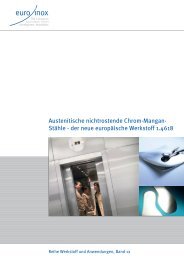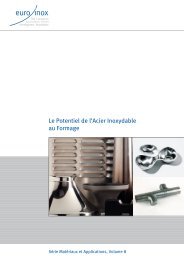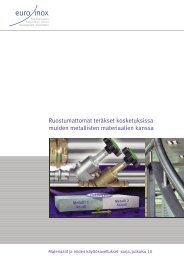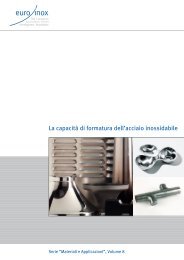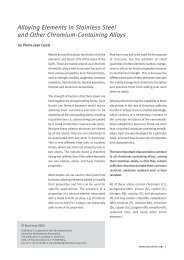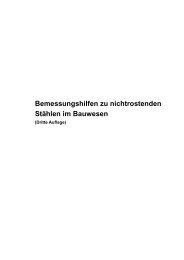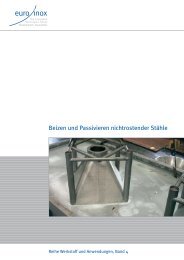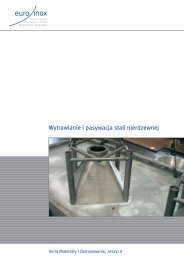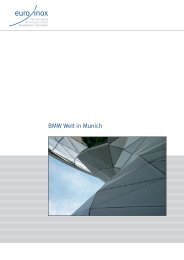Stainless Steel - The Safe Choice - Euro Inox
Stainless Steel - The Safe Choice - Euro Inox
Stainless Steel - The Safe Choice - Euro Inox
You also want an ePaper? Increase the reach of your titles
YUMPU automatically turns print PDFs into web optimized ePapers that Google loves.
SAFE STAINLESS STEEL<br />
1. Introduction<br />
<strong>The</strong> aim of this paper is to show that stainless<br />
steels which have been used in a wide range<br />
of applications such as cooking utensils,<br />
sinks, food and drink industry equipment,<br />
hospital and medical equipment, prothetic<br />
human implants, etc... are safe for human<br />
health.<br />
2. What are <strong>Stainless</strong> <strong>Steel</strong>s ?<br />
<strong>Stainless</strong> steels are defined as iron based alloys<br />
containing at least 10.5 % chromium and<br />
a maximum of 1.2 % carbon.<br />
One of the most important properties of stainless<br />
steels is their resistance to corrosion.<br />
Corrosion resistance in stainless steels is provided<br />
by a passive surface film which acts as<br />
a barrier between the alloy and the surrounding<br />
medium. <strong>The</strong> passive film is a continuous,<br />
non-porous and insoluble film which,<br />
if broken, is self-healing under normal conditions.<br />
Chromium plays an essential role in the formation<br />
and the stabilisation of the passive<br />
film. Other elements can influence the effectiveness<br />
of chromium in forming or maintaining<br />
the film, but no other element can, by<br />
itself, create the properties of stainless steels.<br />
Increasing the chromium content from 10.5 %<br />
to the 18 % level typical of the austenitic<br />
stainless steels, provides increased stability<br />
of the passive film. In austenitic stainless<br />
steels, the nickel content does not contribute<br />
directly to the composition of the passive<br />
film, but does promote repassivation, especially<br />
in reducing atmospheres.<br />
Molybdenum in combination with chromium<br />
is very effective in stabilising the passive film<br />
in the presence of chlorides. It also considerably<br />
improves the resistance to pitting and<br />
crevice corrosion in neutral chloride solutions.<br />
3. What is harmful to health ?<br />
Everything taken in by the body or affecting<br />
it in excess can have a negative influence,<br />
whether it be the level of nutrition, special<br />
foodstuffs, drugs, metallic trace elements or<br />
even vitamins.<br />
<strong>The</strong> reasonings of Paracelsus (1493 - 1541)<br />
are valid still today :<br />
“What is not poisonous ?<br />
Everything is poisonous.<br />
Only the dose makes a thing not<br />
poisonous.”<br />
Following this definition no material could be<br />
regarded as toxic “a priori”. One has also to<br />
notice that the toxicological behaviour of metallic<br />
alloys depends strongly on the valence<br />
state of the metal.<br />
© <strong>Euro</strong> <strong>Inox</strong> 2002 www.euro-inox.org · 2



